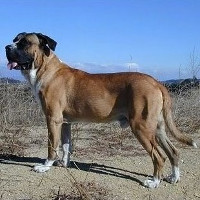Appearance of the Lakota Mastino
|
| The Lakota Mastino is a large dog, with a very muscular, yet agile body built for working dog sports. The skull is broad, strong and muscular, with extra skin. The stop is rather abrupt. The nose is broad and black, red or any color. The muzzle is moderately long, with a straight nasal bridge. Jaws are powerful, with upper and lower jaw strength. Teeth are super-strong with a scissor bite. The eyes are intense when alert, of any color, with a dignified expression. Ears are naturally small, rather thin, set high on the skull or with a working dog crop. The neck is thick and muscular, with a dewlap. The body is muscular, long and low for long-distance running. The withers are high. The back is level and straight. The tail is high, thick at the root, reaching to the hocks, tapering at the end. May or may not be docked, depending on the breeder. Shoulders are moderately sloping. Forearms are large, moderately long and strong. The hindquarters are powerful and capable. The Lakota Mastino has a short, dense coat, permitted in all colors, but preferred in shades of black, blue and brindle, with or without small white markings. Double tracking, powerful, capable of cadence for long distances. |
Temperament of the Lakota Mastino
|
| The Lakota Mastino is a big, strong dog, lighter and more agile than the modern neo, and more powerful than most bouleDogues. The most important characteristic of the Lakota Mastino is its stable temperament. Driven, energetic and highly intelligent, this courageous breed is highly trainable and excels in sports such as personal protection, pull-weight, Mondio Ring and similar activities. The Lakota Mastino shows strong prey and defense attacks, and has a temperament perfect for working dog training tasks and is highly intelligent. Its temperament is marked by patience, composure, boldness and courage. He is energetic and willing to be active. Careful, he's on the lookout and attentive to his environment. A Lakota Mastino should be aware of what's going on around him. It may be the glance or a quick glance, but few things go unnoticed. When working, he is determined and resolute in a decision and maintain an intense and constant focus on the task at hand. This breed is fearless and will face the unknown with a confident, steady attitude. Alert and aware of the environment and ready to respond. Loyal, with loyalty to its master; it has the desire to give 100% without question and remains firm in defending and supporting its master's needs. In the ring, obedience is a positive attitude towards the handler and a desire to please. Stability, confidence, courage, neatness, toughness, sociability and sensitivity are characteristics for which the Lakota Mastino is renowned. |
Needs and activities of the Lakota Mastino
|
| When training for protection, a dog should be brought along slowly to build confidence and understanding. A dog should not be hurt or frightened in order to elicit aggression. If neither prey nor defensive postures elicit a response, the dog either doesn't have the right reflexes or isn't mature enough to handle the job. Some owners inappropriately encourage aggression in their dogs outside of protection training. They don't. They sometimes fail to keep control of the dog, often delighting in their dog's macho behavior. Working dog training will not change the dog's basic temperament. It will give you a good insight into the total temperament of the stressed dog. An angry dog will always be angry. A Lakota Mastino will always be stable and should demonstrate a high level of performance, ability and courage. As a property guardian, the Lakota Mastino is a calm, calculated and intuitive watchdog, but when it feels threatened and must protect its territory and the master's family from an intruder, the Lakota Mastino becomes an intimidating and convincing watchdog. safeguard its threats with quick and precise actions. The Lakota Mastino can be aggressive and on guard when needed, and the Lakota Mastino is a very stable and noble breed, making a wonderful family companion, gentle with children and totally devoted to its master and family. The perfect balance. He's an intelligent, calm dog, choosing his battles carefully and reacting only when necessary. Early socialization and proper training are very important, as is responsible handling, as the Lakota Mastino can sometimes be confronted with strange dogs without him. Fairly playful and loving of its human family, the Lakota Mastino requires a lot of exercise and leadership. Bred with other pedigree dogs and small animals, this beautiful breed accepts them as part of its pack. This breed is not for the passive owner who has no intention of working the dog. It needs a strong leader who understands the dog's behavior. |
Maintenance of the Lakota Mastino
|
| These giant short-haired dogs are easy to groom. Remove loose, dead hair with a rubber brush. This breed is a medium excretor. |







 English (United Kingdom)
English (United Kingdom)